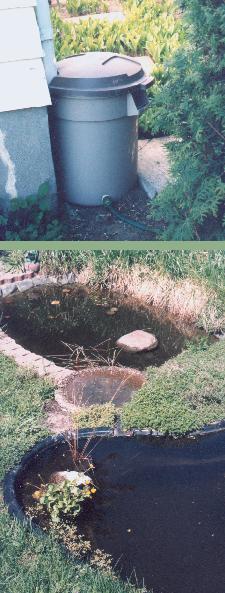Ten years later, I had 6 species of birds nesting on it - cardinal, song sparrow and chippy in the back hedge, starlings in a box, 3 house sparrows in boxes, and robins on top of one of the sparrow boxes. Each summer day, I typically had 20 species as visitors (landing, not just flying overhead). My final total was 41.
You can do it too! Here is how:
Build Healthy Soil
The health of all life begins with the soil. Healthy soil is alive, consisting mostly of living roots and living organisms that recycle dead things back into living ones. There has to be a process for recycling every last bit of every living thing in that soil. All those processes have to work together, in a self-stabilizing ecology, for true soil health.
All pesticides are designed to reduce biodiversity, to disrupt ecologies. If you want healthy soil, you have to stop using them. You have to stop killing things and start growing things. (more on this)
Grasses grow their food in their green parts - the more green they have, the better. Their roots work best when shaded from the sun, cool and moist. So, healthy grass is thick and tall. If your mower can't be raised to cut at a height of 6 cm (2½ inches), fix it, or get a better one. (more on this)
Grasses are the weediest plants on earth, but even they can't grow everywhere. A healthy lawn is green, mowable, comfortable to walk on in bare feet, and good to wiggle your toes in. It doesn't have to be 100% grass. Yarrow grows much better than grass in the mulch of hulls that builds up under a bird feeder, thyme better between stones of a walkway - both are naturally mowed-grass height. Lily-of-the-valley is a better ground cover than anything else in total shade, the native fringed loosestrife Lysimachia ciliata or Lamium album selections good in deep shade. More choices here. All make your soil more biodiverse than pure grass.
Provide Water
Water attracts more summer birds than any bird feeder or nesting box. Shallow water and a dripping sound work magic. Set up a plastic garbage container to collect the rain from one of your downspouts, and run a small hose from it over to a series of birdbaths, set in the ground so that the water runs through them in sequence for a day after each rain. Fill the container with a hose once each day that it doesn't rain. Even better, put in a small pond with shallow edges, or rocks that stick out of the water a bit. (more on this)
Grow Food
Fruit-bearing shrubs and trees that hold their fruit through winter and into the spring supply natural food for many birds when they most need it. Crabapples grow reliably in Ottawa, and are widely available. The variety 'Profusion' is slow growing, but nothing beats it here as a reliable robin tree in the spring (unless a flock of waxwings strips it during winter!).
Consider the space around your home as a meadow with paths in it, rather than as a blank area with patches of flowers around it. Virtually all insects cause us no distress or harm, and a large number are beneficial in that they keep the insects that bother us under control. Meadows are the places to grow healthy insect populations - the best bird food of all. (more on this)
Provide Shelter
Most people think first of bird houses when they think of attracting birds. Actually, that should be the last thing you do - get everything else right for birds first. A high thick cedar hedge is the best there is for breaking winter winds on an urban lot here. A shrubby berry or small-fruit tree gives safe refuge in summer - birds best avoid the predator they can see to dodge.
There are other notes on making birds feel at home around you in Enjoying the Birds of the Ottawa Valley
John Sankey 1988
other notes on nature studies
Matheson House List 2004
barn swallow
black-capped chickadee
blue jay
Bohemian waxwing
brown-headed cowbird
cardinal
catbird
cedar waxwing
chipping sparrow
common grackle
crow
downy woodpecker
evening grosbeak
flicker
fox sparrow
goldfinch
green heron
grey catbird
hairy woodpecker
house finch
house sparrow
hummingbird
junco
mallard
mourning dove
pine siskin
purple finch
red-winged blackbird
redpoll
robin
rock dove
rose-breasted grosbeak
sharp-shinned hawk
song sparrow
starling
tree sparrow
tree swallow
white-breasted nuthatch
white-crowned sparrow
white-throated sparrow
yellow-rumped warbler

a rain barrel feeding a multi-level pond with rocks and shallow spots for birds

a visiting tree sparrow